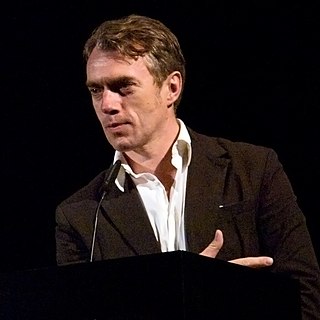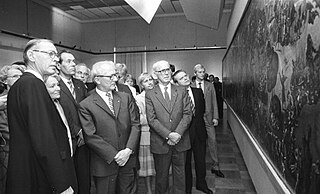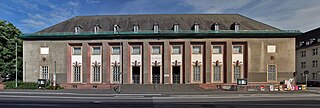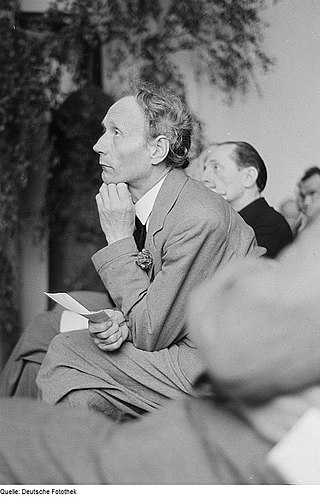
Thomas Müntzer was a German preacher and theologian of the early Reformation whose opposition to both Martin Luther and the Roman Catholic Church led to his open defiance of late-feudal authority in central Germany. Müntzer was foremost amongst those reformers who took issue with Luther's compromises with feudal authority. He was a leader of the German peasant and plebeian uprising of 1525 commonly known as the German Peasants' War.

Neo Rauch is a German artist whose paintings mine the intersection of his personal history with the politics of industrial alienation. His work reflects the influence of socialist realism, and owes a debt to Surrealists Giorgio de Chirico and René Magritte, although Rauch hesitates to align himself with surrealism. He studied at the Hochschule für Grafik und Buchkunst Leipzig, and he lives in Markkleeberg near Leipzig, Germany and works as the principal artist of the New Leipzig School. The artist is represented by Galerie EIGEN + ART Leipzig/Berlin and David Zwirner, New York.

The Battle of Frankenhausen was fought on 14 and 15 May 1525. It was an important battle in the German Peasants' War and the final act of the war in Thuringia: joint troops of Landgrave Philip I of Hesse and Duke George of Saxony defeated the peasants under their spiritual leader Thomas Müntzer near Frankenhausen in the County of Schwarzburg.

Bad Frankenhausen is a spa town in the German state of Thuringia. It is located at the southern slope of the Kyffhäuser mountain range, on an artificial arm of the Wipper river, a tributary of the Unstrut. Because of the nearby Kyffhäuser monument dedicated to Emperor Frederick Barbarossa, it is nicknamed Barbarossastadt. The municipality includes the villages of Seehausen, Udersleben, Esperstedt and Ichstedt and Ringleben.
Matthias Weischer is a painter living in Leipzig. Weischer is considered to be part of the New Leipzig School.
Christoph Ruckhäberle is an artist based in Leipzig. Ruckhäberle studied at the California Institute of the Arts from 1991 to 1992, and received his BFA in painting in 1995 and his MFA in 2002 from Hochschule für Grafik und Buchkunst in Leipzig. He is associated with the New Leipzig School.

Franz Fühmann was a German writer who lived and worked in East Germany. He wrote in a variety of formats, including short stories, essays, screenplays and children's books. Influenced by Nazism in his youth, he later embraced socialism.

Werner Tübke was a German painter, best known for his monumental Peasants' War Panorama located in Bad Frankenhausen. Associated with the Leipzig School, he is "one of the few East German artists who gained recognition in West Germany."
Erich Carl Kissing is a German painter known for his themes and his high-precision glazing technique. Erich Kissing was born on 1943 in Leipzig, Germany. He has a twin sister and a brother six years his senior. Their father worked as a plumber and in other crafts and their mother was a housewife. Kissing lives and works in the house his parents built in Leipzig in 1935.
Hartmut Piniek is a German painter.

Rainer Kirsch was a German writer and poet.

The Bildindex der Kunst und Architektur is an open online database of 2.2 million photographs of 1.7 million artworks and architectural objects. The owner/operator of this database is the German Documentation Center for Art History known formally as Bildarchiv Foto Marburg.
Axel Krause, born 23 October 1958 in Halle (Saale), is a German painter and graphic artist. He is associated with the New Leipzig School and lives and works in Leipzig. He studied at the Hochschule für Grafik und Buchkunst Leipzig in 1981–1986. He taught at the school in 1989–1999 and worked for the Leipzig Opera in 1990–1993.
Beatrice von Bismarck is a German art historian, curator, author and professor for art history and Bildwissenschaft.

Heinz Eberhard Strüning was a German painter, graphic artist and pastel painter.
Gerhard Eichhorn was a German graphic artist, painter and draughtsman.
Dietrich Burger is a German painter and graphic artist.
Peter Sylvester was a German painter and graphic artist.
Karl Krug was a German painter.

Philippine Wolff-Arndt was a German painter. Despite difficult access to an artistic education, she was active in this profession throughout her life. She was also committed to socially disadvantaged people and campaigned for women's rights, for example as a co-founder of the Leipzig Women Artists' Association. In Leipzig, she also fought for the Hochschule für Grafik und Buchkunst Leipzig to be the first art academy in Germany to admit women to study.










